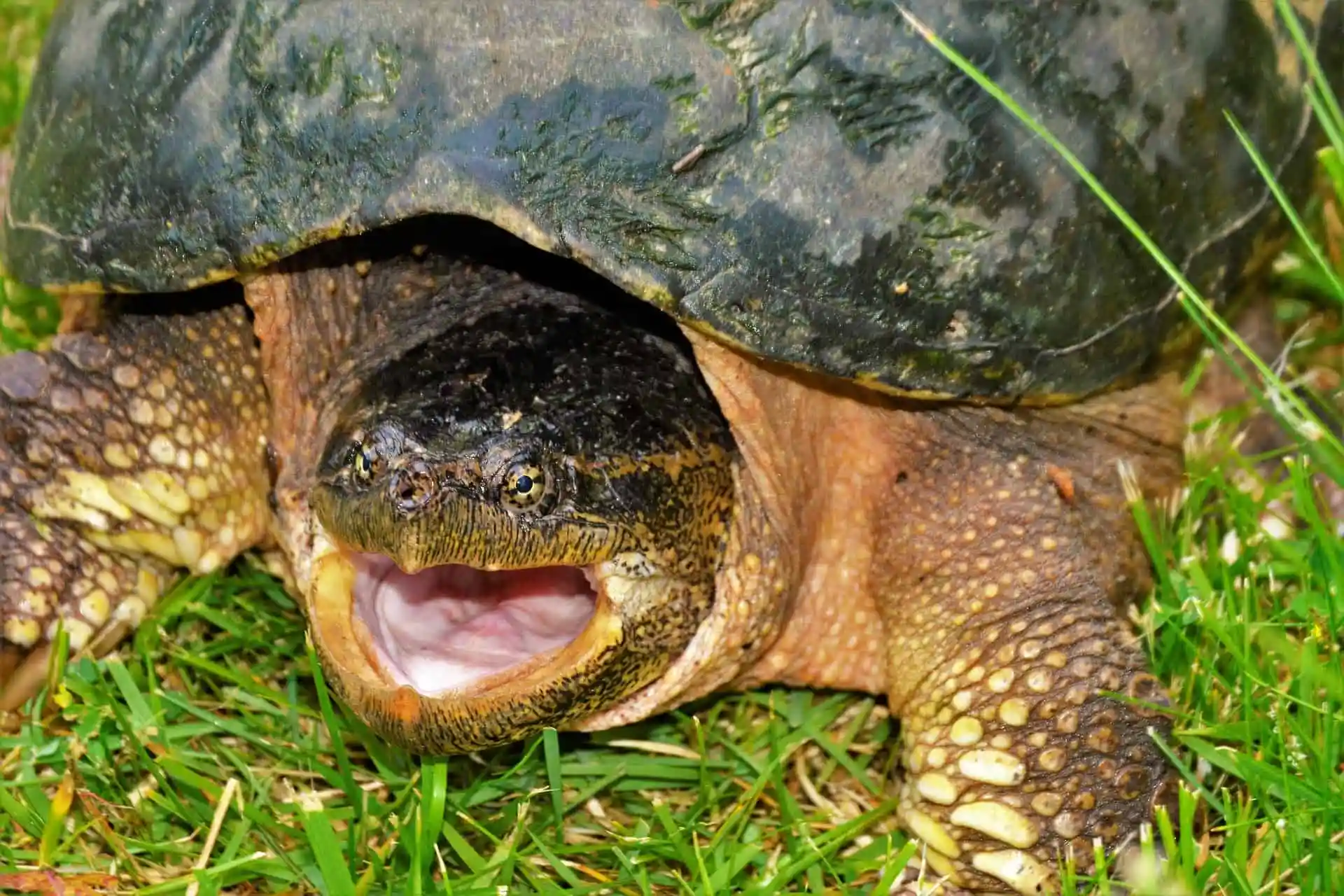Dive into the fascinating world of snapping turtles, where their voracious appetites take center stage! These aquatic predators are always on the hunt, using their unique techniques to conquer a wide range of prey. From delicate vegetation to unsuspecting insects and even larger animals, snapping turtles chow down on whatever crosses their path. Their diverse diet not only keeps them well-fed but also plays a key role in the balance of ecosystems. Join us as we explore the ins and outs of what these hungry critters eat and how it all fits into the big picture.
Did you know that snapping turtles have a unique way of hunting their prey? These turtles lie in wait at the bottom of a body of water, using their long necks to quickly snap at any unsuspecting fish or frog that swims by. If you want to know more about these fascinating creatures, including what they eat and their habitat, click on the links provided!
What do Snapping Turtles Eat?
Snapping turtles are the ultimate opportunistic eaters, consuming a fascinating variety of foods in the wild. Their diet, approximately 70% meat and 30% plants, highlights their adaptability and role as both predator and scavenger.
Key Points on Snapping Turtle Diet:
- Omnivorous: Consume both plants and animals.
- Diverse Palate: Includes algae, moss, duckweed, minnows, eels, frogs, toads, mice, rats, ducks, geese (especially young ones), insects, worms, other invertebrates, fruits, and vegetables.
- Alligator Snapping Turtles: Primarily carnivorous, preferring fish, mollusks (snails, clams), and amphibians.
- Powerful Jaws: Allow them to crush shells and swallow prey whole.
- Ecological Role: Help maintain ecosystem balance by controlling other animal populations.
Let’s explore this diverse palate further:
| Category | Food Items |
|---|---|
| Aquatic Delights | Algae, Moss, Duckweed |
| Finned Friends | Minnows, Eels |
| Amphibious Snacks | Frogs, Toads |
| Land Lubbers | Mice, Rats |
| Feathered Feasts | Ducks, Geese (especially vulnerable young ones!) |
| Crawling Cuisine | Insects, Worms, Other Invertebrates |
| Sweet Treats | Fruits, Vegetables (when available) |
Snapping turtles aren’t known for their table manners. They use those powerful jaws, capable of delivering a bone-crushing bite, to crush shells and swallow prey whole. This efficient hunting style makes them formidable predators in their aquatic habitats.
But it’s not just about satisfying their hunger. Snapping turtles play a crucial role in maintaining the delicate balance of their ecosystems. By keeping other animal populations in check, they prevent overgrazing of plants and maintain a healthy diversity of species. They are also a part of the food chain, sometimes becoming meals for larger predators like alligators and crocodiles, further demonstrating the interconnectedness of life in their watery world.
The Wild Diet of Snapping Turtles: Hunters, Scavengers, and Opportunistic Feeders
Snapping turtles have adapted to thrive in various aquatic environments thanks to their incredibly diverse diet and flexible feeding strategies. They are not picky eaters, consuming almost anything they can find, from aquatic plants and insects to small mammals and carrion. This “eat-what-you-can-catch” approach makes them true survivors.
Key Lines:
- Snapping turtles possess an exceptionally diverse diet, ranging from aquatic plants to small mammals, reflecting their opportunistic feeding behavior.
- Despite their formidable appearance, common snapping turtles consume a significant portion of aquatic plants as a nutritional source.
Hunters: Apex Predators with a Bite
Despite their slow movements, snapping turtles are skilled ambush predators, lurking patiently beneath the water’s surface, waiting for unsuspecting prey to wander too close. Their powerful jaws snap shut with lightning speed, making them a force to be reckoned with. Fish, amphibians, snakes, and even the occasional unlucky duck have fallen victim to their swift attacks. Their willingness to take on prey larger than themselves solidifies their position as apex predators in their environment.
Scavengers: Cleaning Up the Waterways
Snapping turtles also play a crucial role as scavengers, consuming dead animals and decaying plants. This often-overlooked aspect of their diet is essential for maintaining the health of their aquatic ecosystems. By breaking down organic matter, they act as nature’s recyclers, preventing the buildup of decaying matter and keeping the waterways clean.
Opportunistic Feeders: Taking Advantage of What’s Available
Snapping turtles are masters of opportunism, readily taking advantage of any readily available food source. Whether it’s insects buzzing near the surface, worms wriggling in the mud, or a juicy berry that has fallen from an overhanging branch, they’re quick to capitalize on the opportunity. This adaptability allows them to thrive in various habitats, from pristine lakes to murky swamps.
Snapping Turtle Menu: A Glimpse at the Variety
| Category | Food Items |
|---|---|
| Plants | Algae, Duckweed, Water Lilies, Fallen Fruit |
| Invertebrates | Insects, Worms, Crayfish, Snails |
| Fish | Minnows, Bass, Catfish, Sunfish |
| Amphibians | Frogs, Tadpoles, Salamanders |
| Reptiles | Snakes, Turtles (yes, even smaller snapping turtles!) |
| Birds | Ducklings, Small Waterfowl |
| Mammals | Mice, Shrews, Muskrats |
| Other | Carrion (dead animals), Organic Debris |
Key Takeaways:
- Snapping turtles have incredibly diverse palates, munching on everything from delicate plants to unsuspecting critters.
- They’re skilled hunters with a lightning-fast bite, but also play a vital role as scavengers, keeping their watery homes clean.
- As opportunistic eaters, they’re adaptable and resourceful, able to find meals in various habitats.
Conclusion
The next time you see a snapping turtle basking in the sun, remember you’re looking at a true survivor. Their incredible diet is a testament to their adaptability and crucial role in maintaining the delicate balance of our ecosystems. They might not be the cuddliest creatures in the animal kingdom, but they are a fascinating example of nature’s ingenuity!
Snapping Turtle Diet in Captivity: A Guide to Proper Nutrition
Providing a balanced diet for captive snapping turtles is crucial for their health and well-being. Just like their wild counterparts, they require a mix of protein, vegetables, and calcium to thrive.
Key Lines:
- Snapping turtles in captivity require a balanced diet consisting of protein, vegetables, and calcium sources.
- Adult snapping turtles can be fed every 2-3 days, while juveniles may require daily feedings.
- Common and alligator snapping turtles in captivity should have their diet supplemented with leafy greens.
What Does a Hungry Snapping Turtle Eat? Protein Power!
Live insects and worms are an excellent source of protein for captive snapping turtles. They can be purchased at most pet stores and mimic the turtles’ natural prey. Raw, lean meats like chicken or turkey, cut into manageable pieces, can also be offered.
Condensed & Organized Context:
Diet Composition:
- Protein: Fish, earthworms, insects, raw lean meats (chicken, turkey).
- Vegetables: Water hyacinth, water lettuce, duckweed, leafy greens.
- Calcium: Commercial turtle food pellets, cuttlebone.
Feeder fish can be a special treat but ensure they are from a reputable source and gut-loaded with nutritious food before offering them to your turtle. This ensures the fish are healthy and provide maximum nutritional value.
Veggies Aren’t Just for Humans: Greens on the Shell!
Leafy greens like water hyacinth, water lettuce, and duckweed are essential for snapping turtles, providing vitamins and minerals that contribute to their overall health, including shell strength and development. These aquatic plants can be grown in the turtle’s tank or purchased from pet stores. Commercial turtle food pellets often contain vegetables, offering a convenient way to ensure your turtle receives a balanced diet.
Calcium: The Building Block for a Strong Shell
Calcium is essential for maintaining a snapping turtle’s strong, healthy shell. Cuttlebone, readily available in the bird section of most pet stores, is a natural calcium source that can be floated in the turtle’s tank. They will nibble on it as needed. Many commercial turtle food pellets are fortified with calcium to ensure they receive adequate amounts.
How Often Should I Feed My Snapping Turtle?
Feeding frequency depends on the turtle’s age, activity level, and individual metabolism. Adult snapping turtles typically eat every 2-3 days, while younger, growing turtles may need to eat daily. Observe your turtle’s eating habits and adjust their feeding schedule accordingly.
Feeding Frequency:
- Adults: Every 2-3 days.
- Juveniles: Possibly daily.
A Few More Turtle-ific Tips!
- Watch and Learn: The best way to know how much to feed your turtle is to pay attention to how much they eat. If food is always left over, you might be giving them too much.
- No Appetite? A snapping turtle that’s not hungry could signify stress, incorrect water temperature, or illness. Consult a veterinarian if you notice any changes in their eating habits.
- Variety is the Spice of Life! Just like we enjoy different foods, offering your snapping turtle a variety of food ensures they’re getting a balanced diet.
- Clean Up Crew: Snapping turtles can be messy eaters. Removing any uneaten food after feeding time will help keep their water clean.
- A Happy Turtle is a Well-Fed Turtle: Seeing your snapping turtle happy and thriving is incredibly rewarding. Providing them with a proper diet is a key part of responsible turtle ownership.
The Digestive System of a Snapping Turtle: Built for an Omnivorous Lifestyle
The snapping turtle’s digestive system is a marvel of adaptation, efficiently processing both plant and animal matter, showcasing their omnivorous nature.
Key Lines:
- Snapping turtles are opportunistic omnivores with a varied diet that includes both plant and animal matter.
- While meat comprises a majority of their diet, they also consume a substantial amount of aquatic vegetation.
- As skilled predators, they use their sharp claws, powerful beak, and ambush tactics to capture prey.
- The digestive system of snapping turtles is well-adapted to process both meat and plant-based materials.
Key Takeaways:
- Omnivore Advantage: Snapping turtles aren’t picky eaters; they’re opportunists, grabbing whatever’s on the menu. This “eat-anything” strategy helps them thrive in different environments.
- Plant Power: Don’t let those powerful jaws fool you! Aquatic plants make up a big chunk of a snapping turtle’s diet, giving them essential vitamins and fiber.
- Built for Greens: Their intestines are long, winding roads specifically designed to break down tough plant material. This is where the magic of cellulose digestion happens.
- Tools of the Trade: Those sharp teeth and claws aren’t just for show! They’re essential for tearing and crushing food into bite-sized pieces, making digestion a whole lot easier.
- Out with the Old: Not everything is digestible. Shells and other tough bits are either thrown up or pass right through their system.
A Balancing Act
Snapping turtles play a crucial role in maintaining the intricate balance of their aquatic ecosystems. Their diverse diet, including both live prey and dead matter, makes them essential players in the circle of life. Their consumption of vegetation helps control plant growth, preventing overgrowth and ensuring a healthy habitat for other species.
Condensed & Organized Context:
Dietary Habits:
- Snapping turtles are omnivorous, consuming both plants (30%) and animals (70%).
- Their animal prey includes worms, snails, fish, birds, small mammals, and even other turtles.
- They may also feed on carrion or dead animals if available.
Hunting Techniques:
- Snapping turtles are stealthy hunters that ambush their prey.
- They use their sharp claws to cling to prey, while their hooked beak delivers a powerful bite.
- Their long necks allow them to strike at prey from a concealed position.
Digestive System:
- The snapping turtle’s digestive system features long intestines specialized for digesting cellulose found in plants.
- Their teeth and sharp claws play a role in breaking down food into smaller pieces.
- Undigested material, such as fragments of shells, is regurgitated or passed through their digestive tract.
A Curious Bite
The sheer volume of vegetation that snapping turtles can consume raises intriguing questions about their nutritional needs and how their diet influences their overall health and reproductive success. Scientists are continually conducting research to unravel these mysteries and gain a deeper understanding of these fascinating creatures.
In Conclusion:
Snapping turtles, with their adaptable digestive systems and opportunistic eating habits, are a testament to nature’s creativity and resilience. By studying their digestion, we gain a better understanding of their biology and the vital role they play in maintaining the health and vibrancy of aquatic ecosystems.

















Comments are closed.